In many countries, developing wind power is an important part of an energy strategy intent on moving away from fossil fuels. In Canada, there’s no lack of petroleum. It has the third largest petroleum reserves of any country in the world and exports 2.7 million barrels of oil a day. But Canada is committed to reducing dependence on carbon-emitting energy sources to combat global warming. Developing wind power stations is one way Canadians are helping. Wind power might seem like an obvious good choice, but wind turbines have their own set of problems. People do not always enjoy living near them. This article will look at the pros and cons of wind farms and describe the top 10 largest ones in the country.
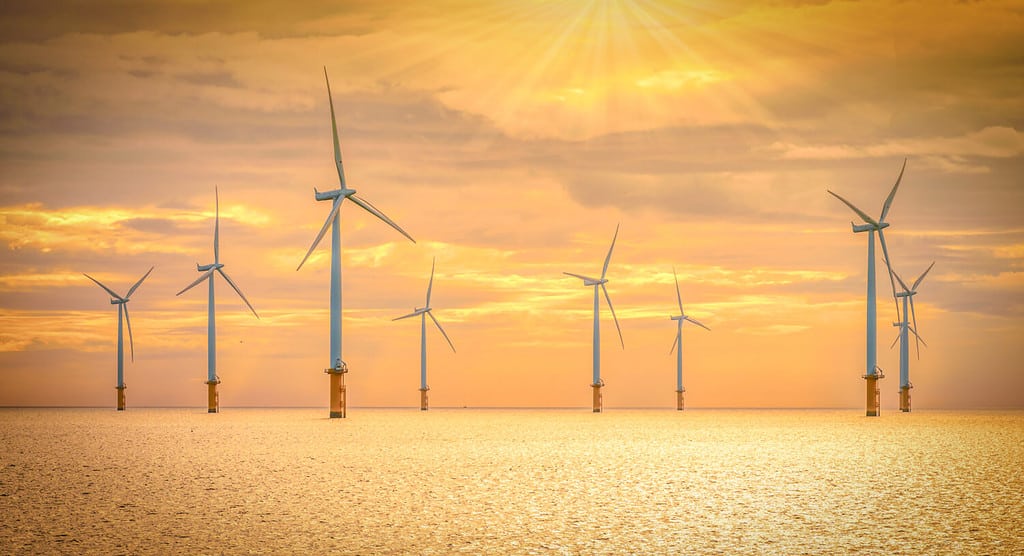
Many countries are building wind turbines to combat global warming. This one is off England’s coast.
©Nuttawut Uttamaharad/Shutterstock.com
How Do Wind Turbines Work?
Any electric generator runs on the same principle: the object is to create electricity by spinning a generator. You spin it by attaching turbine blades. The faster the blades turn, the more electricity is generated. A great many methods of generating electricity depend upon heating water into steam, which rotates the turbine blades. This is how coal, gas, geothermal, and nuclear plants create energy. Hydroelectric power uses water flowing through a dam to achieve the same goal. And wind turbines use the power of the wind. When many wind turbines are built close together in a particular location, this is called a wind farm.
Wind turbines cost about $73,000, but installation doubles that cost. On average, the total diameter of the rotors of today’s wind turbines is over 430 feet. This is longer than a football field, and twice as much as a 747’s wingspan! The blades are made mainly of fiberglass so that they can be lightweight and will respond to the slightest breeze. Believe it or not, scientists have recently developed a new type of resin that may be used in wind turbines in the future that can actually be recycled into edible gummy bears!

Would you eat gummy bears made of recycled wind turbines?
©Nodar Chernishev/Shutterstock.com
Pros of Wind Farms
There are tons of reasons wind farms are a great idea. Here are just a few:
- They are a source of clean, renewable energy. Wind is not a scarce resource.
- Wind power is a domestic energy source. It helps a country be more energy independent. Almost any country could potentially install wind turbines.
- Reduced dependence on petroleum diversifies a country’s energy sources, making it less vulnerable to oil market fluctuations and political threats to oil supplies.
- They don’t cost much to maintain and operate, compared to other energy sources.
- Turbines can be built in small numbers in a short period of time to meet a community’s needs, then more can be built as needed in the future as needs increase.
- Wind farms can be built off a country’s coast or on farmland or pastureland. They don’t take up much land area. The space below and around them can be used for other purposes.
- Wind turbines are 20-40% efficient at converting wind to energy. This is comparable to coal, at 32% efficiency via its energy source, and natural gas at 45% conversion efficiency.
- Property taxes, money spent on operations expenses, and salaries paid to local workers get pumped into the local economy.
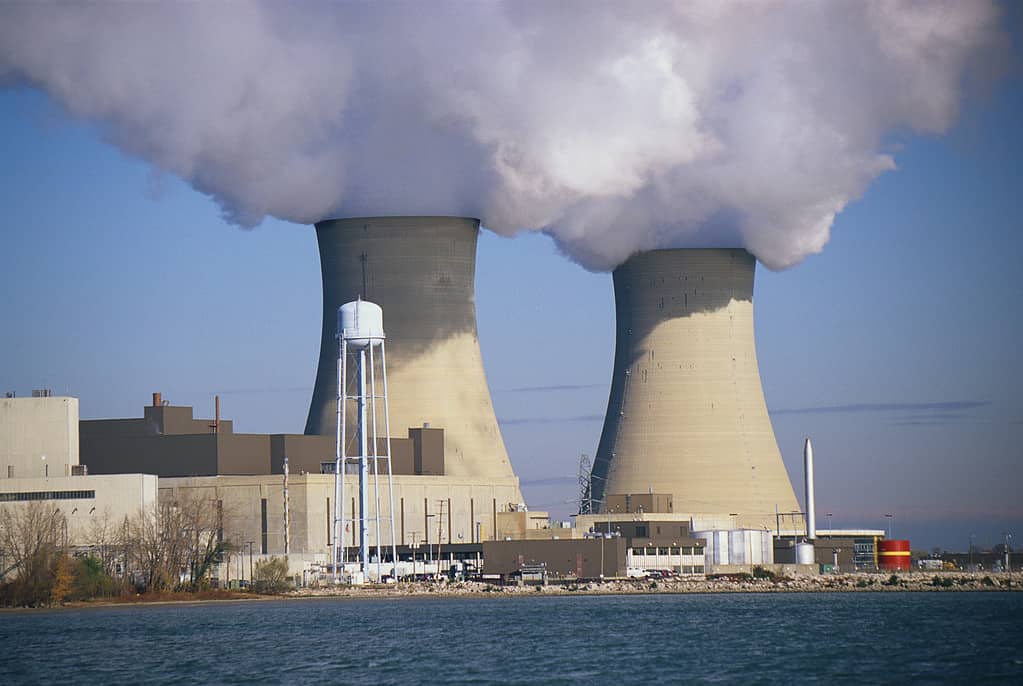
Unlike wind power stations, a nuclear plant costs billions of dollars and takes decades to build.
©Joseph Sohm/Shutterstock.com
Cons of Wind Farms
Things aren’t all blue skies with wind farms, though. Here are some problems with them:
- Some people find them unsightly on the landscape.
- Turbines are made from mined and manufactured materials and must be transported to their location. There is a carbon footprint to the whole process of creating and installing them.
- They do not produce a constant and consistent flow of electricity unless they are in a place where the wind always blows, such as a seashore.
- The windiest areas that are best for wind turbines are often remote from the cities where the electricity is needed. Power sources cannot be too far away from cities, as electricity leaks from long-distance power lines.
- Some birds and bats collide with turbine blades. This is especially a concern when wind farms are on the migratory route of endangered bird species.
- The heavy equipment used to install them on actual farms compresses the soil and crushes irrigation infrastructure, damaging agricultural productivity.
- Switching from petroleum to wind costs jobs in the petroleum industry, which less labor-intensive wind energy jobs cannot completely replace.

Some people find wind turbines unsightly, but if you’re driving across Iowa, you might enjoy them.
©Justin C. Hilts/Shutterstock.com
Are Wind Turbines Noisy?
Some people object to living near wind turbines because they make a swishing or whooshing sound that can be annoying. However, you have to get very close to them to hear it. They are usually located no closer than a third of a mile from the nearest house. The sound level at that distance is about 43 decibels, about as loud as the noise your refrigerator makes. The video below, taken in Michigan, shows that traffic and crickets are actually quite a bit louder.
Top 10 Largest Wind Farms in Canada
1. Seigneurie de Beaupré Wind Farms (Quebec)
Seigneurie de Beaupré Wind Farms is the largest wind farm in Canada. It’s actually three farms adjacent to one another that operate together. Altogether it has 164 turbines generating over 363.5 MW, but there are proposals to expand the farm to generate an additional 300 MW.
2. Rivière-du-Moulin Wind Project (Quebec)
Rivière-du-Moulin Wind Project produces 350 MW of power. Built on public lands in 2014, the project has about 175 wind turbines. EDF Renewables Canada and DIM WIND, each own 42.5% of the project. The facility cost about $800 million to build. It sells energy to Hydro-Quebec in a 20-year purchase agreement.
3. Blackspring Ridge (Alberta)
Blackspring Ridge is located in Vulcan County, Alberta. It is the largest wind farm in Western Canada. Commissioned in 2014, it has 166 turbines generating 300 MW of energy.
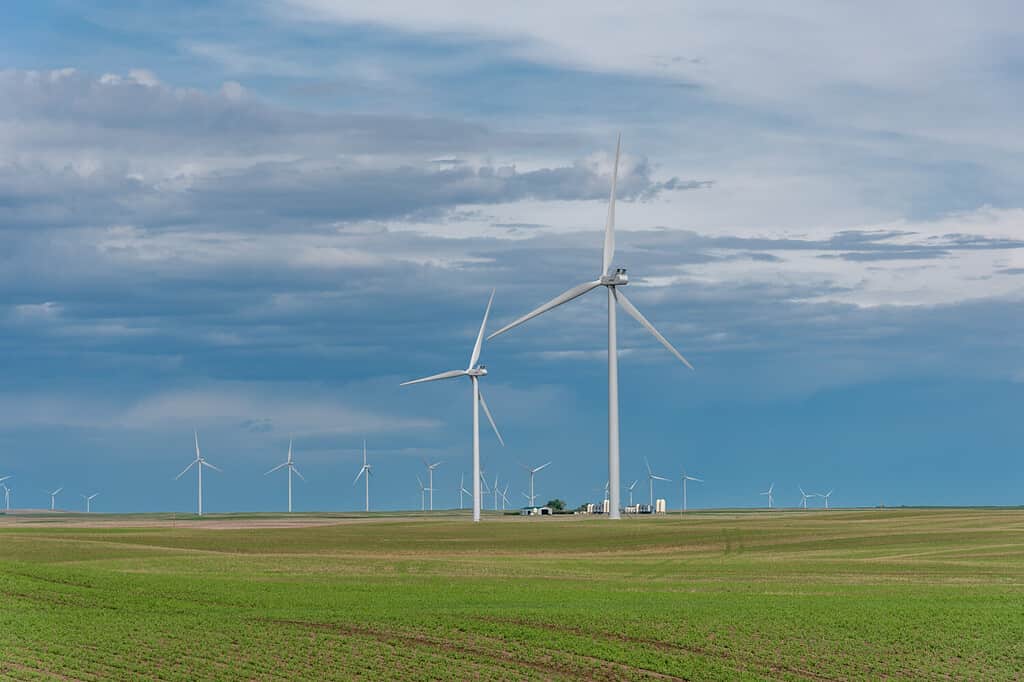
This is Blackspring Ridge Wind Farm, located in southeastern Alberta close to Carmangay.
©Jeff Whyte/Shutterstock.com
4. Henvey Inlet (Ontario)
Henvey Inlet Wind Energy Centre (HIWEC) has the distinction of being located on land belonging to the Henvey Inlet First Nation Community. Construction began in 2017 and operations started two years later. It cost almost $800 million and has a capacity of 300 MW.
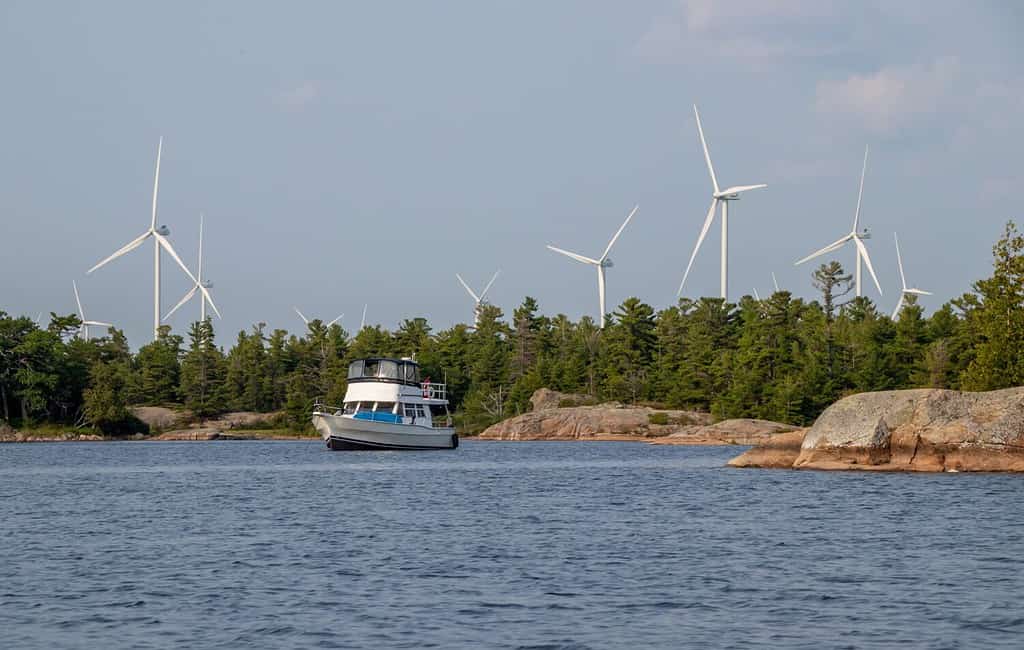
These turbines near Henvey Inlet on Georgian Bay are part of the Henvey Inlet Wind Energy Centre.
©Lynda McFaul/Shutterstock.com
5. Lac Alfred (Quebec)
Lac Alfred is a wind farm in Quebec with a capacity of 300 MW. It cost over $600 million to build and in 2013 started fulfilling a 20-year contract to sell power to Hydro Quebec. The Canada Pension Plan Investment Board and the Enbridge Income Fund are joint owners of the Lac Alfred facility.
6. South Kent Wind Farm (Ontario)
The South Kent Wind Farm is located in Chatham-Kent Municipality on mixed public- and private-use land. Its 101 wind turbines generate 270 MW. The project is a joint venture of Samsung Renewable Energy and Pattern Canada.
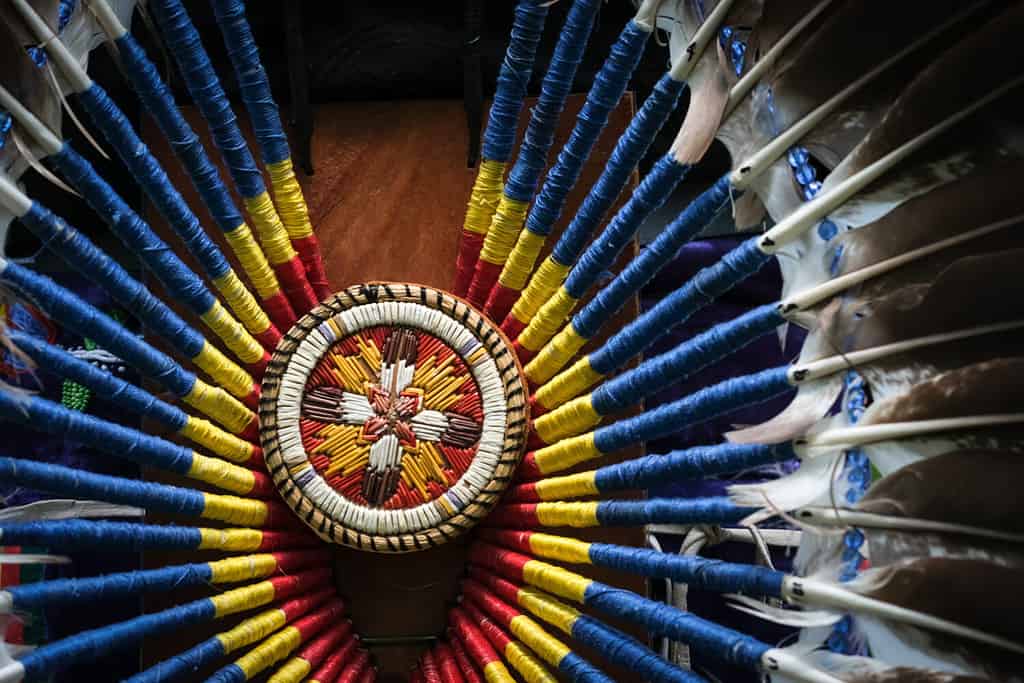
Some of Canada’s wind energy projects are on First Nations land and provide income to the community.
©Clemquetzal/Shutterstock.com
7. K2 Wind Power Facility (Ontario)
K2 Wind Power Facility is located in the township of Ashfield-Colborne-Wawanosh in Ontario. The Alberta Teachers Retirement Fund owns the facility, but Pattern Canada manages it. The facility became operational in 2015. It has 140 wind turbines generating 270 MW.
8. Niagara Region Wind Farm (Ontario)
The Niagara Region Wind Farm is located in the Regional Municipality of Niagara, Ontario. This whole region is treaty land belonging to several First Nations. It’s best known for its most famous natural feature: Niagara Falls, which straddles the border between Canada and the United States. The Niagara Region Wind Farm has 77 turbines. Construction took place in 2015 and the facility began producing 231 MW of power in 2016. The facility’s owners are Boralex, Enercon, and the Six Nations of the Grand River Development Corporation. It has a 20-year contract to sell electricity to Independent Electric Systems Operator.

Niagara Falls is located on the border of
Buffalo
and Ontario. The Niagara Wind Farm is also in the region.
©iStock.com/bloodua
9. Nicolas-Riou Wind (Quebec)
Nicolas-Riou Wind is a facility that cost $500 million to build on public and private leased land. It is located in the Bas-Saint-Laurent region, on the lands of TNO Boisbouscache and the municipalities of Sainte-Françoise, Saint-Mathieu-de-Rioux, Saint-Médard (RCM Basques) and Saint-Eugene-de-Ladrière (RCM of Rimouski-Neigette). Nicolas-Riou has a capacity of 224 MW and supplies clean energy to 35,000 homes. Commissioned in 2018, Nicolas-Riou is under contract to sell electricity to Hydro-Quebec for 20 years.
10. Gros-Morne Wind Farm (Quebec)
Gros-Morne is a wind farm 50 km northwest of Gaspe, Quebec that generates 211 MW. Construction took place in two stages in 2011-2012. Cartier Wind Energy owns the project. GE Renewable Energy manufactured the 141 wind turbines there. Gros-Morne has a 21-year contract to supply energy to Hydro-Quebec.

Gros-Morne Wind Farm is located on the scenic, and windy, Gaspé Peninsula of Quebec.
©Kristi Blokhin/Shutterstock.com
Comparison of the Largest Wind Farms in Canada
| Rank | Name of Wind Farm | Location | Capacity |
|---|---|---|---|
| 1 | Seigneurie de Beaupré Wind Farm | Quebec | 363.5 MW |
| 2 | Rivière-du-Moulin Wind Project | Quebec | 350 MW |
| 3 | Blackspring Ridge | Alberta | 300 MW |
| 4 | Henvey Inlet Wind Energy Centre | Ontario | 300 MW |
| 5 | Lac Alfred | Quebec | 300 MW |
| 6 | The South Kent Wind Farm | Ontario | 270 MW |
| 7 | K2 Wind Power Facility | Ontario | 270 MW |
| 8 | Niagara Region | Ontario | 231 MW |
| 9 | Nicolas-Riou Wind | Quebec | 224 MW |
| 10 | Gros-Morne Wind Farm | Quebec | 211 MW |
Which is Closest to You?
Now you know where the 10 largest wind farms in Canada are located. Which one is closest to you? Maybe you’d like to drive by one of them to see if you can hear the turbines. Do they detract from the view or add futuristic interest to it? If experts could recycle wind turbines into edible gummy bears, would you eat them? If your community were under consideration as a wind farm location, would you be for it or against it? Questions like these could make interesting car conversations the next time you drive past one of these impressive feats of modern engineering.
Thank you for reading! Have some feedback for us? Contact the AZ Animals editorial team.








